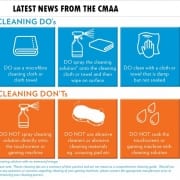PREPARE YOUR “RE-OPENING” WORKFORCE
While workplace design, policies and safety protocols are critical, they do not touch on the readiness of the workforce physically, emotionally and psychologically. Developing a plan to mitigate employee fears and concerns should be a top priority. People have anxieties about their jobs, the future of their organisations and even the future of their industries.
Ensuring employees understand what the workplace will be like upon return is critical.
According to OSH guidance, in preparation for employees returning to work you should:
- Pay special attention to workers who are at high risk and be prepared to protect the most vulnerable.
- Consider putting in place support for workers who may be suffering from anxiety or stress.
- Workers who are returning to the workplace after a period of isolation are likely to have worries, particularly about the risk of infection. These worries – especially if there have been changes to the job – may well result in stress and poor mental health. Provide workers with information on publicly available sources of support and advice.
- Workers might be worried about an increased chance of infection at the workplace and may not want to return. It is important to understand their concerns, provide information about the measures taken and the support available to them.
“It will be vital to have a re-orientation or re-induction process for returning staff. Encourage and support every manager to have one-to-one return meetings with every employee, where a key focus is on health, safety and wellbeing. Managers need to have a sensitive and open discussion with every individual and discuss any adjustments and/or ongoing support they may need to facilitate an effective return to the workplace. This is especially important for those who have been on leave, and should cover topics such as changes in company services or procedures, how specific customer queries or issues are being addressed, or changes in supply arrangements, as well as any changes to their work duties or tasks. It could be that some staff require a phased return to their full role, or want to discuss a new working arrangement, especially if their domestic situation has changed because of the pandemic.”
New policies and procedures
When bringing employees back into the workplace, policies will be important in setting the expectation for employees. Many organisations have allowed flexibility into some of their policies, especially those related to time off, remote working and flexible work schedules.
“Upon setting the new organisational framework coming back into the workplace, organisations should consider what policies need to change or be reinstated. From the employee’s perspective, if policies have been adjusted for an extended period of time – for example, work from home for office employees – this may be viewed as the new norm. Organisations should revisit relevant policies and determine the right approach during the transition back to the physical workplace. Communicating the importance of company policies, including any recent updates, and how they map back to the organisation’s vision will be critical in establishing a climate of employee awareness and compliance.
Legal considerations
Some staff will have been furloughed during the pandemic and these staff, even if they have agreed to an immediate recall, should be given a reasonable period of notice to return, says the CIPD.
This is particularly important given that many people will have additional childcare or other responsibilities, which they may need to make arrangements to manage.
For more information on safe work practice issues in the Australian Hospitality Industry click here: https://www.safeworkaustralia.gov.au/covid-19-information-workplaces/industry-information/hospitality/about-covid-19
To read the full article click here>>> https://www.internationalworkplace.com/en-gb/news/returning-to-work-from-lockdown-preparing-your-workplace-and-workforce-57393













